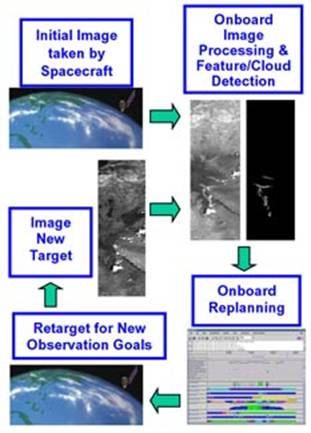The Red (Hot?) Planet
Don't let Mars's cold, quiet demeanor fool you. For much of its history, the Red Planet has been a fiery world.
Dozens of volcanoes that dot the planet's surface stand as monuments to the eruptions that once reddened Mars's skies with plumes of glowing lava. But the planet has settled down in its old age, and these volcanoes have been dormant for hundreds of millions of years.

Or have they? Some evidence indicates that lava may have flowed on Mars much more recently. Images of the Martian surface taken by orbiting probes show regions of solidified lava with surprisingly few impact craters, suggesting that the volcanic rock is perhaps only a million years old.
If so, could molten lava still occasionally flow on the surface of Mars today?
With the help of some artificial intelligence software, a heat-sensing instrument currently orbiting Mars aboard NASA's Mars Odyssey spacecraft could be just the tool for finding active lava flows.
"Discovering such flows would be a phenomenally exciting scientific finding," says Steve Chien, supervisor of the Artificial Intelligence Group at JPL. For example, volcanic activity could provide a source of heat, thus making it more likely that Martian microbes might be living in the frosty soil.
The instrument, called THEMIS (for Thermal Emission Imaging System), can "see" the heat emissions of the Martian surface in high resolution - each pixel in a THEMIS image represents only 100 meters on the ground. But THEMIS produces about five times more data than it can transmit back to Earth.
Scientists usually know ahead of time which THEMIS data they want to keep, but they can't plan ahead for unexpected events like lava flows. So Chien and his colleagues are customizing artificial intelligence software called ScienceCraft to empower THEMIS to identify important data on its own.
This decision-making ability of the ScienceCraft software was first tested in Earth orbit aboard a satellite called Earth Observing-1 by NASA's New Millennium Program. Earth Observing-1 had already completed its primary mission, and the ScienceCraft experiment was part of the New Millennium Program's Space Technology 6 mission.
On Odyssey, ScienceCraft will look for anomalous hotspots on the cold, night side of Mars and flag that data as important. "Then the satellite can look at it more closely on the next orbit," Chien explains.
Finding lava is considered a long shot, but since THEMIS is on all the time, "it makes sense to look," Chien says. Or better yet, have ScienceCraft look for you - it's the intelligent thing to do.
To learn more about the Autonomous ScienceCraft software and see an animation of how it works, visit http://ase.jpl.nasa.gov .